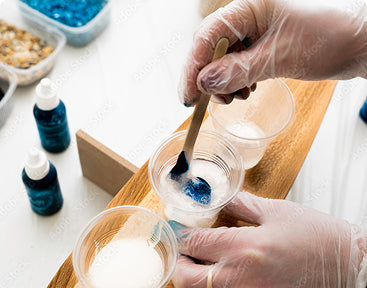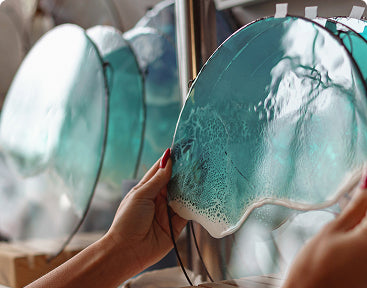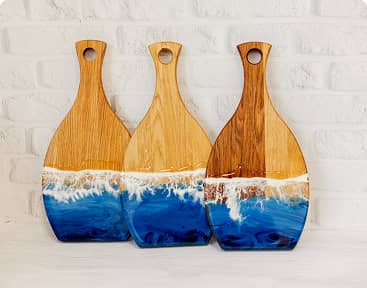Quality Assurance
We guarantee top-quality epoxy resin products that are made to achieve the highest safety standards with our food-safe resin coating, ensuring your peace of mind.
There's something almost magical about watching that first pour flow between pieces of live edge wood, creating those organic patterns that seem to capture flowing water in crystal-clear resin. Your friends will stop mid-conversation when they see your finished river table, running their hands along that perfect transition where wood meets epoxy, asking how on earth you managed to create something so stunning.
The truth is, river tables have become the ultimate test of epoxy craftsmanship, and that's exactly why Epoxy King developed our specialized river table systems. We've watched too many ambitious first-time builders struggle with inferior materials or incomplete kits, ending up with cloudy pours, visible seam lines, or surfaces that never quite achieve that professional mirror finish. Our complete river table solutions eliminate the guesswork by providing everything you need for success, specifically for these challenging projects.
River tables represent the perfect marriage between natural wood beauty and modern material science. Each piece tells a unique story through the organic flow patterns that develop as the epoxy settles into irregular spaces between live edge slabs. The visual depth created by quality clear resin makes the "river" appear to flow beneath the surface, changing appearance as lighting conditions shift throughout the day.
But here's what most people don't realize until they start planning their first project - river tables demand far more precision than standard table applications. The epoxy needs to bond perfectly with irregular wood surfaces, flow smoothly into deep voids, and cure without developing the bubbles or cloudiness that would ruin the illusion of flowing water. Getting all these elements right requires understanding both the materials and the techniques that separate amateur attempts from museum-quality pieces.






Live edge slabs provide the foundation for every river table, and choosing the right pieces can make or break your project before you even open the epoxy containers. Look for slabs with interesting grain patterns and natural edge characteristics that will show beautifully through the clear resin. The wood should be properly dried to prevent movement that could crack the epoxy bond later. Wood preparation becomes critical because any oils, dirt, or loose bark will interfere with epoxy adhesion. Some exotic woods contain natural oils that require special sealing procedures, while others may need stabilizing treatments to prevent air bubbles from migrating through the epoxy during curing. Understanding your specific wood type helps predict potential challenges and plan appropriate preparation steps.
Standard table epoxies simply won't work for river table applications because they lack the deep pour characteristics needed for thick sections. River Table Epoxy Resin formulations allow pours up to several inches thick without the excessive heat buildup that causes cracking or bubbling in regular products. These specialized systems also provide extended working time essential for large projects.
Flow characteristics become paramount when creating those smooth, organic river patterns that make these tables so appealing. The epoxy needs to self-level beautifully while conforming to irregular wood surfaces and settling into deep voids without leaving visible pour lines. Premium formulations achieve this balance through careful chemistry that optimizes viscosity and cure timing for artistic applications.
Successful river tables start with careful planning that considers both aesthetic goals and practical constraints. Think about how the finished piece will be used and where it will live - a dining table faces different requirements than a decorative console piece. The river width, depth, and pattern all affect both appearance and structural integrity.
Positioning the wood slabs requires patience and often multiple adjustments to achieve the desired river flow pattern. Some builders create templates or mock-ups to test different arrangements before committing to the final layout. Consider how the grain patterns will interact with the epoxy flow and whether any natural features in the wood might interfere with the desired aesthetic.
River table projects demand more extensive tool requirements than standard epoxy applications. You'll need larger mixing containers, longer stirring tools, and often specialized equipment for handling heavy slabs safely. A proper workspace with adequate ventilation becomes crucial when working with the larger quantities of epoxy these projects require.
Temperature control throughout the workspace affects both working time and final results. Uneven temperatures can cause flow problems or differential curing that shows up as visible lines in the finished river. Planning for climate control and having backup heating or cooling options prevents weather-related project delays that could compromise your results.
Surface preparation starts with ensuring both wood and work surface are completely clean and level. Any contamination or surface irregularities will telegraph through the final finish, potentially ruining months of work. Use appropriate sanders and cleaners to achieve the surface quality your project deserves.
Sealing porous wood prevents air bubbles from migrating through the epoxy during the long cure times these thick pours require. Some woods need multiple sealer coats, while others may require specialized penetrating sealers to achieve adequate bubble prevention. Don't rush this step - proper sealing makes the difference between success and failure.
Multiple pour stages often work better than attempting to complete thick sections in single pours. This approach provides better heat management and allows correction of any problems before they become permanent. Each pour stage needs careful timing to ensure proper bonding between layers without visible demarcation lines.
Flow control techniques help achieve the organic patterns that make river tables so appealing. Some builders use temporary barriers or guides to direct the epoxy flow, while others rely on careful pouring techniques and gravity to create natural-looking patterns. Understanding how viscosity changes during curing helps predict and control final patterns.
Clear epoxy showcases the natural wood beauty most effectively, but color additions can create stunning artistic effects. Pigments, metallic powders, and specialty additives allow customization while maintaining the transparency that makes river tables so captivating. Each additive affects working properties differently, requiring adjustment of techniques.
Layering techniques create depth effects that make the river appear even more realistic. Some builders incorporate multiple colors or transparency levels to simulate the way real water looks at different depths. These advanced techniques require practice and understanding of how different materials interact during curing.
River tables often require more epoxy than smaller projects, making material planning crucial. Running out of mixed epoxy mid-pour creates problems that are difficult or impossible to correct later. Calculate quantities carefully and have backup materials available for unexpected situations or corrections.
Timing becomes critical when working with large quantities because pot life doesn't change even when using more material. Plan the entire process carefully, have helpers available if needed, and ensure all tools and materials are ready before starting the mixing process. Once you begin, there's no stopping until the pour is complete.
Long cure times for thick epoxy sections require environmental stability throughout the process. Temperature fluctuations, humidity changes, or contamination during the extended cure period can affect final quality. Plan for workspace isolation and environmental control throughout the multi-day curing process.
Heat management becomes particularly important with thick pours because the chemical reaction generates significant heat that can cause cracking or other problems if not properly controlled. Understanding the relationship between thickness, ambient temperature, and reaction heat helps predict and prevent curing problems.
Sanding and polishing thick epoxy sections requires different techniques than thin coatings. The material behaves more like solid plastic, allowing aggressive sanding if needed but also requiring careful attention to avoid creating flat spots or other surface irregularities. Work through progressive grits to achieve the mirror finish that makes river tables so striking.
Edge finishing determines how the river transitions meet the wood surfaces. Clean, precise edges where epoxy meets wood separate professional results from amateur attempts. This often requires hand work with specialized tools to achieve the crisp lines that make the river illusion convincing.
Bubble formation in thick sections can ruin months of work, making prevention far more important than attempted corrections. Understanding the sources of bubbles - from wood outgassing to mixing technique - helps prevent these problems before they occur. Once bubbles are trapped in thick sections, removal becomes extremely difficult.
Flow problems that create uneven river patterns often result from temperature issues, contamination, or improper surface preparation. These problems typically become apparent only after it's too late to correct them, emphasizing the importance of proper planning and preparation.
River table projects represent significant material investments, making careful planning essential. Quality live edge slabs command premium prices, and the specialized epoxy systems required for deep pours cost more than standard formulations. Budget for both primary materials and the specialized tools these projects require.
Waste minimization becomes important when working with expensive materials. Careful measurement, proper mixing techniques, and having appropriate containers for excess material help control costs while ensuring adequate supplies for successful completion.
Skill development for river table creation takes time and practice. While the basic concepts aren't complicated, achieving professional results requires understanding materials, techniques, and troubleshooting that comes through experience. Consider starting with smaller projects to develop skills before tackling large dining tables.
Professional installation services may be worthwhile for particularly valuable slabs or when the finished piece needs to meet specific quality standards. Understanding what professionals can provide helps determine when DIY approaches make sense versus when expert help justifies the additional cost.
Finished river tables require minimal maintenance when properly constructed with quality materials. Regular cleaning with appropriate products maintains the clarity and protective properties that make these pieces so beautiful. Understanding proper care procedures protects your significant investment in materials and time.
Refinishing options exist for river tables that develop damage over time, though the process is more complex than standard table refinishing. Understanding repair possibilities and limitations helps with both initial design decisions and long-term care planning.
Our river table kits include everything needed for successful projects, from deep-pour epoxy formulations to detailed instructions written specifically for these challenging applications. This eliminates compatibility concerns while ensuring adequate supplies for proper thickness and coverage requirements.
Technical support specific to river table applications helps troubleshoot problems and optimize results throughout the project. Understanding the unique challenges these projects present allows us to provide guidance that generic suppliers simply can't match.
Ventilation requirements become particularly important when working with the large quantities of epoxy river tables require. Adequate airflow protects both applicator health and ensures optimal curing conditions for the best possible results. Plan workspace ventilation carefully before starting any large project.
Material handling safety for heavy slabs requires appropriate equipment and techniques. River table slabs often weigh hundreds of pounds, making safe handling procedures essential for both personal safety and material protection. Invest in proper lifting and support equipment rather than risking injury or damage.

We guarantee top-quality epoxy resin products that are made to achieve the highest safety standards with our food-safe resin coating, ensuring your peace of mind.

With years of experience in the industry, we have the knowledge and expertise to provide you with the best solutions for your food-safe projects.

Our extensive range of epoxy resin products offers options for every need and budget, ensuring that you find the perfect fit for your project.

At Epoxy King, customer satisfaction is our priority. We strive to exceed your expectations with our products and service, earning your trust and loyalty.

When you choose Epoxy King, you can count on reliable products and dependable service every time. Trust us for all your food-safe epoxy needs and experience the difference.
Here’s a comprehensive FAQ that covers various aspects
Our deep-pour formulations handle sections up to 2-3 inches in single pours, though multiple thinner pours often provide better results and easier heat management. Deeper sections require multiple pour stages with proper timing between layers to ensure good bonding.
Most river table projects need 45-90 minutes of working time depending on size and complexity. Our formulations provide extended pot life specifically for these demanding applications, but proper planning and preparation remain essential for success.
Yes, but additives must be compatible with deep-pour formulations and used according to guidelines. Some colorants affect curing characteristics, so testing is recommended before committing to large projects. Transparent tints often work better than opaque pigments for maintaining the water illusion.
Initial hardness develops within 48-72 hours for thick sections, but full cure and maximum strength take 7-14 days depending on thickness and environmental conditions. Plan for extended cure times when scheduling project completion.
Cloudiness typically results from moisture contamination, inadequate mixing, or environmental conditions during curing. Prevention through proper technique and environmental control works much better than attempting corrections after problems develop.
Minor surface defects often sand out successfully, but problems within thick sections are usually permanent. This emphasizes the importance of proper planning, preparation, and technique to prevent problems rather than attempting repairs later.
Calculate based on river dimensions plus 10-20% extra for mixing waste and potential touch-ups. Our kits include quantity calculators specific to river table applications, ensuring adequate materials without excessive waste.
Proper mold construction and release techniques create the cleanest edges, though some hand finishing is usually required. Planning edge details during the design phase prevents problems and reduces finishing work.
Whether you're creating your first river table or perfecting advanced techniques, our specialized systems provide the materials and guidance needed for professional results. The combination of quality deep-pour formulations, appropriate tools, and expert support makes the difference between disappointing attempts and heirloom pieces that showcase your craftsmanship for generations.
